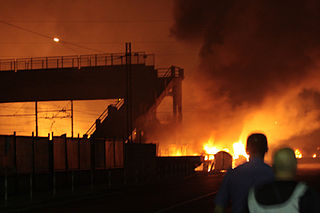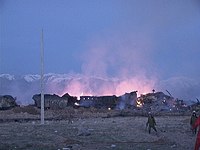The Ryongchŏn disaster was a train disaster that occurred on 22 April 2004 in the town of Ryongchŏn, North Korea, near the border with the People's Republic of China. At least 54 people were killed, including some Syrian scientists.
The Sarai Banjara rail disaster occurred on 2 December 2000, when a derailed freight train crossed onto the opposite track early in the morning in Punjab, India. A Howrah–Amritsar Express a passenger train coming from other direction hit the freight train head-on at speed, killing 46 people and injuring at least 150.
The Karanjadi train crash was an accident resulting in derailment of a passenger train at Karanjadi, a village in Maharashtra, India, on 17 June 2004. 20 people were killed and well over 100 injured in the crash, which was the result of heavy monsoon rains.

The Thirsk rail crash occurred on 31 July 1967 at Thirsk, Yorkshire, England on the British Rail East Coast Main Line.
The railways of New South Wales, Australia have had many incidents and accidents since their formation in 1831. There are close to 1000 names associated with rail-related deaths in NSW on the walls of the Australian Railway Monument in Werris Creek. Those killed were all employees of various NSW railways. The details below include deaths of employees and the general public.

The Viareggio derailment was the derailment and subsequent fire of a freight train carrying liquefied petroleum gas. It occurred on 29 June 2009 in a railway station in Viareggio, Lucca, a city in Central Italy's Tuscany region. Thirty-two people were killed and a further twenty-six were injured.

The Soham rail disaster occurred on 2 June 1944, during the Second World War, when a fire developed on the leading wagon of a heavy ammunition train. The wagon contained a quantity of high explosive bombs. The train crew had detached the wagon from the rest of the train and were drawing it away when the cargo exploded. The fireman of the train and the signalman at Soham signalbox were killed and several other people injured. The driver, Benjamin Gimbert, and fireman, James Nightall, were both awarded the George Cross for preventing further damage which would have occurred if the rest of the train had exploded.
This is a list of significant railway accidents in Queensland, Australia.

Two trains collided on the main line in Semnan Province between Semnan and Damghan, Iran, on 25 November 2016, resulting in 49 deaths and 103 injuries. There were reported difficulties with the rescue operation due to the incident's remote location 4 km from the nearest station, Haft-Khan, and because only one helicopter could reach the scene immediately to join the rescue operation. It was the deadliest rail disaster in Iran since the Nishapur train disaster in 2004.

On 10 December 2016, a freight train derailed, exploded and caught fire in the village of Hitrino in Shumen Province, Bulgaria, killing at least seven people and injuring 29 others.

On the night of Wednesday, June 21, 1905, the New York Central Railroad's flagship passenger train, the 20th Century Limited, derailed in Mentor, Ohio, on the Lake Shore and Michigan Southern Railway line, killing 21 passengers and injuring more than 25 others on board. A switch from the mainline to a freight siding was open, causing the Limited to leave the mainline and overrun the siding at high speed. The cause of the accident was never officially determined, but overwhelming evidence points to an act of rail sabotage. The 20th Century Limited connected New York City to Chicago; its running time had just weeks earlier been reduced from 20 hours to 18.
The 2004 Nosratabad fuel tanker explosion was a catastrophic incident that took place on 24 June 2004, near Iran's border with Afghanistan, resulting in at least 90 fatalities and 114 injuries. The disaster occurred when a petrol truck lost control and collided with a bus at the Nosratabad police checkpoint, located about 110 kilometres (68 mi) west of Zahedan.







